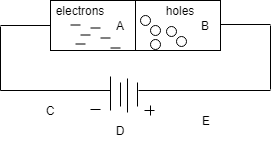
In the diagram, section A represents:

A) N-type germanium
B) P-type germanium
C) Anode
D) Diode
Answer
219.6k+ views
Hint: From figure when external source is applied then the charges get aligned and the excess of electrons gathers at one place and holes at the opposite side. Excess of electrons is N and holes are of P type.
Complete solution:
Step 1:
Before starting the solution let us know about N and P type semiconductor.
An N-type semiconductor is a type of material used in electronics. It is made by adding an impurity to a pure semiconductor such as silicon or germanium. The impurities used may be phosphorus, arsenic, antimony, bismuth or some other chemical element. They are called donor impurities.
A P-type semiconductor is a type of semiconductor. When the trivalent impurity is added to an intrinsic or pure semiconductor (silicon or germanium), then it is said to be a p-type semiconductor. Trivalent impurities such as Boron, Gallium, Indium, Aluminum etc are called acceptor impurity.
Step 2:
In N-type material there are electrons energy levels near the top of the band gap so that they can be easily excited into the conduction band. In P-type material, extra holes in the band gap allow excitation of valence band electrons, leaving mobile holes in the valence band.
So from the figure we can see that A has more number of electrons and B part has the maximum number of holes so A represents N-type Germanium.
Hence, option A is correct.
Additional information: Anode: The anode is the electrode where electricity moves into. The cathode is the electrode where electricity is given out or flows out of. The anode is usually the positive side.
Cathode: A cathode is the metallic electrode through which current flows out in a polarized electrical device. Cathodes get their name from cations (positively charged ions) and anodes from anions (negatively charged ions). In a device that uses electricity, the cathode is the negatively charged electrode.
Note: Semiconductors are especially made up of germanium and silicon because they have free electrons in their outer shell and hence offer conductivity. Germanium at a given temperature offers more free electrons than silicon. That’s why they are widely used in transistors and other electronic devices.
Complete solution:
Step 1:
Before starting the solution let us know about N and P type semiconductor.
An N-type semiconductor is a type of material used in electronics. It is made by adding an impurity to a pure semiconductor such as silicon or germanium. The impurities used may be phosphorus, arsenic, antimony, bismuth or some other chemical element. They are called donor impurities.
A P-type semiconductor is a type of semiconductor. When the trivalent impurity is added to an intrinsic or pure semiconductor (silicon or germanium), then it is said to be a p-type semiconductor. Trivalent impurities such as Boron, Gallium, Indium, Aluminum etc are called acceptor impurity.
Step 2:
In N-type material there are electrons energy levels near the top of the band gap so that they can be easily excited into the conduction band. In P-type material, extra holes in the band gap allow excitation of valence band electrons, leaving mobile holes in the valence band.
So from the figure we can see that A has more number of electrons and B part has the maximum number of holes so A represents N-type Germanium.
Hence, option A is correct.
Additional information: Anode: The anode is the electrode where electricity moves into. The cathode is the electrode where electricity is given out or flows out of. The anode is usually the positive side.
Cathode: A cathode is the metallic electrode through which current flows out in a polarized electrical device. Cathodes get their name from cations (positively charged ions) and anodes from anions (negatively charged ions). In a device that uses electricity, the cathode is the negatively charged electrode.
Note: Semiconductors are especially made up of germanium and silicon because they have free electrons in their outer shell and hence offer conductivity. Germanium at a given temperature offers more free electrons than silicon. That’s why they are widely used in transistors and other electronic devices.
Recently Updated Pages
A square frame of side 10 cm and a long straight wire class 12 physics JEE_Main

The work done in slowly moving an electron of charge class 12 physics JEE_Main

Two identical charged spheres suspended from a common class 12 physics JEE_Main

According to Bohrs theory the timeaveraged magnetic class 12 physics JEE_Main

ill in the blanks Pure tungsten has A Low resistivity class 12 physics JEE_Main

The value of the resistor RS needed in the DC voltage class 12 physics JEE_Main

Trending doubts
JEE Main 2026: Application Form Open, Exam Dates, Syllabus, Eligibility & Question Papers

Understanding Uniform Acceleration in Physics

Derivation of Equation of Trajectory Explained for Students

Hybridisation in Chemistry – Concept, Types & Applications

Understanding the Angle of Deviation in a Prism

Understanding Collisions: Types and Examples for Students

Other Pages
JEE Advanced Marks vs Ranks 2025: Understanding Category-wise Qualifying Marks and Previous Year Cut-offs

Understanding Atomic Structure for Beginners

How to Convert a Galvanometer into an Ammeter or Voltmeter

Understanding Centrifugal Force in Physics

JEE Main Marking Scheme 2026- Paper-Wise Marks Distribution and Negative Marking Details

Degree of Dissociation: Meaning, Formula, Calculation & Uses




